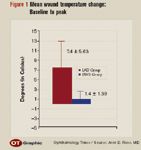Article
In vivo study establishes thermal safety benefits of micropulse phaco
Washington, DC—"Cold" phaco can truly be performed using micropulse technology whereas operating with conventional pulse mode can result in significant heat generation and the potential for wound burn, said Aron D. Rose, MD, at the annual meeting of the American Society of Cataract and Refractive Surgery.
Washington, DC-"Cold" phaco can truly be performed using micropulse technology whereas operating with conventional pulse mode can result in significant heat generation and the potential for wound burn, said Aron D. Rose, MD, at the annual meeting of the American Society of Cataract and Refractive Surgery.

To evaluate what type of power modulation technology allows truly "cold phaco," Dr. Rose performed an open-label study that randomly assigned 27 eyes to undergo cataract removal using either the Sovereign with WhiteStar (AMO) (15 eyes) or the Legacy AdvanTec with NeoSonix (Alcon Laboratories) (12 eyes). Surgery was performed using the CF setting (6 msec on, 12 msec off) for WhiteStar and pulse mode at 12 pulses per second for the Legacy AdvanTec system.

In addition, the temperature increased by 4.5° C in all eyes during micropulse surgery, whereas it increased by 5° C in eight (67%) of 12 eyes operated on with pulse mode and rose by 11° to 15° C in four (33%) of the 12 eyes. Furthermore, the maximum temperature achieved was significantly higher in the Legacy AdvanTec group compared with the WhiteStar group (51° versus 35.4° C), he said.
"There have been conflicting reports in the literature regarding what pulse modulation features allow for truly cold phaco, but many of the studies that have examined this question used laboratory in vitro models. I chose to explore this issue in vivo by measuring temperature changes at the wound site during actual surgery," Dr. Rose explained.

Newsletter
Don’t miss out—get Ophthalmology Times updates on the latest clinical advancements and expert interviews, straight to your inbox.




